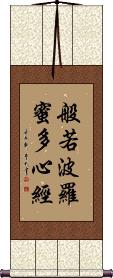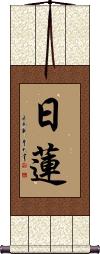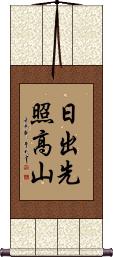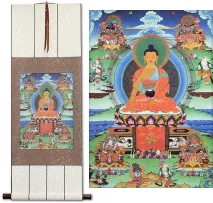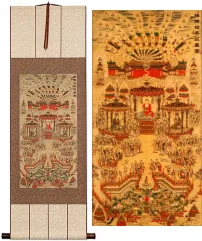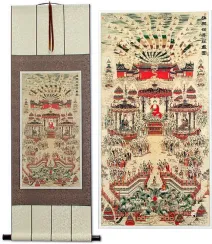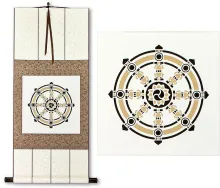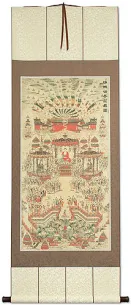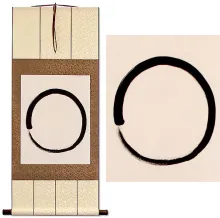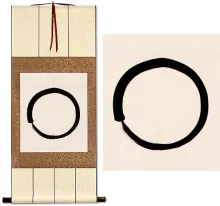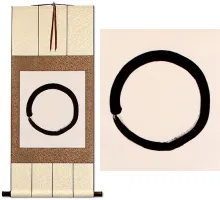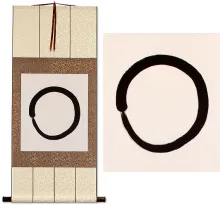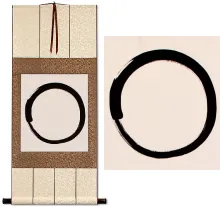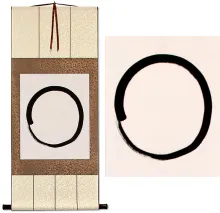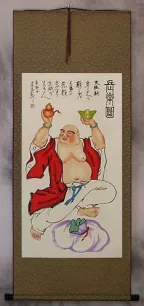Many custom options...
And formats...

The name Buddhist Sutra in Chinese / Japanese...
Buy a Buddhist Sutra calligraphy wall scroll here!
Personalize your custom “Buddhist Sutra” project by clicking the button next to your favorite “Buddhist Sutra” title below...
Heart Sutra
This is the Heart Sutra in Chinese as translated by Xuanzang.
The Heart Sutra is often cited as the best-known and most popular of all Buddhist scriptures.
Notes: There are too many characters for this to be done by the economy calligrapher. You must choose a Master Calligrapher.
With this many characters, and the fact that one tiny mistake wipes out hours of work, keep in mind that writing the Heart Sutra is usually a full day of work for a calligrapher. This work and personal energy should be cherished and respected. In other words, the calligrapher is not charging enough money for the value that you are getting here.
Also, you will find that as my server processes 260 characters, the customization process is a bit slow for this title.
Heart Sutra Title
Nichiren
日蓮 is the title Nichiren.
This title refers to a Buddhist priest who lived from 1222 to 1282. He is the founder of the Nichiren sect of Buddhism.
According to historical documents, the Nichiren sect was established in 1252. Adding the character 宗 for sect, this would be 日蓮宗 (Nichiren sect), which is also known as the 法華宗 or Lotus sect.
According to Soothill-Hodous...
Nichiren's chief tenets are the three great mysteries 三大祕法, representing the trikāya:
1. 本尊 or chief object of worship, being the great maṇḍala of the worlds of the ten directions, or universe, i.e., the body or nirmāṇakāya of Buddha.
2. 題目 the title of the Lotus Sutra 妙法蓮華經 Myo-ho-ren-ge-kyo, preceded by Namo, or “Adoration to the scripture of the lotus of the wonderful law,” for it is Buddha's spiritual body.
3. 戒壇 the altar of the law, which is also the title of the Lotus as above; the believer, wherever he is, dwells in the Pure-land of calm light 寂光淨土, the saṃbhogakāya.
When the sun rises it first shines on the highest mountain
This old Buddhist phrase means, “When the sun rises it always shines first on the highest mountain,” or “When the sun appears, it first casts its light upon the highest mountain.”
This comes from the Avatamsaka Sutra and has been used as the name or portion of the name for temples in Japan and sites in China.
The Buddha's first round of teaching (Avatamsaka period) is likened to the time when the sun rises from the east horizon. When the sun first rises it illuminates the high mountains. In this analogy, the high mountains represent the great Bodhisattvas and/or those most ready to receive enlightenment and liberation.
This can be romanized from Japanese as “Nichi shutsu sen shō kō san,” “Nisshutsu saki teru takayama,” or “Hide temazu kōzan wo terasu yama.” The last one is probably the most common. Ask three Japanese people what they think the pronunciation is, and you will get three different opinions.
This in-stock artwork might be what you are looking for, and ships right away...
Gallery Price: $200.00
Your Price: $88.88
Gallery Price: $200.00
Your Price: $69.88
Not the results for buddhist sutra that you were looking for?
Below are some entries from our dictionary that may match your buddhist sutra search...
| Characters If shown, 2nd row is Simp. Chinese |
Pronunciation Romanization |
Simple Dictionary Definition |
佛 see styles |
fó fo2 fo hotoke ほとけ |
More info & calligraphy: Buddhism / Buddha(surname) Hotoke Buddha, from budh to "be aware of", "conceive", "observe", "wake"; also 佛陀; 浮圖; 浮陀; 浮頭; 浮塔; 勃陀; 勃馱; 沒馱; 母馱; 母陀; 部陀; 休屠. Buddha means "completely conscious, enlightened", and came to mean the enlightener. he Chinese translation is 覺 to perceive, aware, awake; and 智 gnosis, knowledge. There is an Eternal Buddha, see e.g. the Lotus Sutra, cap. 16, and multitudes of Buddhas, but the personality of a Supreme Buddha, an Ādi-Buddha, is not defined. Buddha is in and through all things, and some schools are definitely Pan-Buddhist in the pantheistic sense. In the triratna 三寳 commonly known as 三寳佛, while Śākyamuni Buddha is the first "person" of the Trinity, his Law the second, and the Order the third, all three by some are accounted as manifestations of the All-Buddha. As Śākyamuni, the title indicates him as the last of the line of Buddhas who have appeared in this world, Maitreya is to be the next. As such he is the one who has achieved enlightenment, having discovered the essential evil of existence (some say mundane existence, others all existence), and the way of deliverance from the constant round of reincarnations; this way is through the moral life into nirvana, by means of self-abnegation, the monastic life, and meditation. By this method a Buddha, or enlightened one, himself obtains Supreme Enlightenment, or Omniscience, and according to Māhāyanism leads all beings into the same enlightenment. He sees things not as they seem in their phenomenal but in their noumenal aspects, as they really are. The term is also applied to those who understand the chain of causality (twelve nidānas) and have attained enlightenment surpassing that of the arhat. Four types of the Buddha are referred to: (1) 三藏佛the Buddha of the Tripiṭaka who attained enlightenment on the bare ground under the bodhi-tree; (2) 通佛the Buddha on the deva robe under the bodhi-tree of the seven precious things; (3) 別佛the Buddha on the great precious Lotus throne under the Lotus realm bodhi-tree; and (4) 圓佛the Buddha on the throne of Space in the realm of eternal rest and glory where he is Vairocana. The Hīnayāna only admits the existence of one Buddha at a time; Mahāyāna claims the existence of many Buddhas at one and the same time, as many Buddhas as there are Buddha-universes, which are infinite in number. |
日蓮 日莲 see styles |
rì lián ri4 lian2 jih lien nichiren にちれん |
More info & calligraphy: NichirenNichiren, the Japanese founder, in A. D. 1252, of the 日蓮宗 Nichiren sect, which is also known as the 法華宗 or Lotus sect. Its chief tenets are the three great mysteries 三大祕法, representing the trikāya: (1) 本尊 or chief object of worship, being the great maṇḍala of the worlds of the ten directions, or universe, i. e. the body or nirmāṇakāya of Buddha; (2) 題目 the title of the Lotus Sutra 妙法蓮華經 Myo-ho-ren-gwe-kyo, preceded by Namo, or, 'Adoration to the scripture of the lotus of the wonderful law, ' for it is Buddha's spiritual body; (3) 戒壇 the altar of the law, which is also the title of the Lotus as above; the believer, wherever he is, dwells in the Pure-land of calm light 寂光淨土, the saṃbhogakāya. |
無我 无我 see styles |
wú wǒ wu2 wo3 wu wo muga むが |
More info & calligraphy: Selflessness(1) selflessness; self-effacement; self-renunciation; (2) {Buddh} anatta; anatman; doctrine that states that humans do not possess souls; (female given name) Muga anātman; nairātmya; no ego, no soul (of an independent and self-contained character), impersonal, no individual independent existence (of conscious or unconscious beings, anātmaka). The empirical ego is merely an aggregation of various elements, and with their disintegration it ceases to exist; therefore it has nm ultimate reality of its own, but the Nirvāṇa Sūtra asserts the reality of the ego in the transcendental realm. The non-Buddhist definition of ego is that it has permanent individuality 常一之體 and is independent or sovereign 有主宰之用. When applied to men it is 人我, when to things it is 法我. Cf. 常 11. |
觀世音 观世音 see styles |
guān shì yīn guan1 shi4 yin1 kuan shih yin Kanzeon かんぜおん |
More info & calligraphy: Guan Shi Yin: Protector Of Life(out-dated kanji) Avalokiteshvara (Bodhisattva); Avalokitesvara; Kannon; Kwannon; Guanyin; Buddhist deity of compassion Regarder of the world's sounds, or cries, the so-called Goddess of Mercy; also known as 觀音; 觀世音善薩; 觀自在 (觀世自在); 觀尹; 光世音 (the last being the older form). Avalokiteśvara, v. 阿 8. Originally represented as a male, the images are now generally those of a female figure. The meaning of the term is in doubt; it is intp. as above, but the term 觀自在 (觀世自在) accords with the idea of Sovereign Regarder and is not associated with sounds or cries. Guanyin is one of the triad of Amida, is represented on his left, and is also represented as crowned with Amida; but there are as many as thirty-three different forms of Guanyin, sometimes with a bird, a vase, a willow wand, a pearl, a 'thousand' eyes and hands, etc., and, when as bestower of children, carrying a child. The island of Putuo (Potala) is the chief centre of Guanyin worship, where she is the protector of all in distress, especially of those who go to sea. There are many sūtras, etc., devoted to the cult, but its provenance and the date of its introduction to China are still in doubt. Chapter 25 of the Lotus Sūtra is devoted to Guanyin, and is the principal scripture of the cult; its date is uncertain. Guanyin is sometimes confounded with Amitābha and Maitreya. She is said to be the daughter of king Śubhavyūha 妙莊王, who had her killed by 'stifling because the sword of the executioner broke without hurting her. Her spirit went to hell; but hell changed into paradise. Yama sent her back to life to save his hell, when she was miraculously transported on a Lotus flower to the island of Poo-too'. Eitel. |
戒 see styles |
jiè jie4 chieh kai; ingoto(ok) かい; いんごと(ok) |
to guard against; to exhort; to admonish or warn; to give up or stop doing something; Buddhist monastic discipline; ring (for a finger) (1) (かい only) {Buddh} admonition; commandment; (2) sila (precept) śīla, 尸羅. Precept, command, prohibition, discipline, rule; morality. It is applied to the five, eight, ten, 250, and other commandments. The five are: (1) not to kill; (2 ) not to steal; (3) not to commit adultery; (4) not to speak falsely; (5) not to drink wine. These are the commands for lay disciples; those who observe them will be reborn in the human realm. The Sarvāstivādins did not sanction the observance of a limited selection from them as did the 成實宗 Satyasiddhi school. Each of the five precepts has five guardian spirits, in all twenty-five, 五戒二十五神. The eight for lay disciples are the above five together with Nos. 7, 8, and 9 of the following; the ten commands for the ordained, monks and nuns, are the above five with the following: (6) not to use adornments of flowers, nor perfumes; (7) not to perform as an actor, juggler, acrobat, or go to watch and hear them; (8) not to sit on elevated, broad, and large divans (or beds); (9) not to eat except in regulation hours; (10) not to possess money, gold or silver, or precious things. The 具足戒full commands for a monk number 250, those for a nun are 348, commonly called 500. Śīla is also the first of the 五分法身, i.e. a condition above all moral error. The Sutra of Brahma's Net has the following after the first five: (6) not to speak of the sins of those in orders; (7) not to vaunt self and depreciate others; (8) not to be avaricious; (9) not to be angry; (10) not to slander the triratna. |
佛經 佛经 see styles |
fó jīng fo2 jing1 fo ching bukkyō |
Buddhist texts; Buddhist scripture Buddhist canonical literature; also Buddha's image and sutras, with special reference to those purporting to have been introduced under Han Mingdi; sutras probably existed in China before that reign, but evidence is lacking. The first work, generally attributed to Mingdi's reign, is known as The Sutra of Forty-two Sections 四十二章經 but Maspero in B.E.F.E.O. ascribes it to the second century A.D. |
六部 see styles |
rokubu ろくぶ |
(1) six copies; (2) (abbreviation) (See 六十六部) Buddhist pilgrim (carrying 66 copies of the Lotus Sutra to be left at sites across Japan); (surname) Rokube |
四衆 四众 see styles |
sì zhòng si4 zhong4 ssu chung shishu; shishuu / shishu; shishu ししゅ; ししゅう |
(1) four orders of Buddhist followers (monks, nuns, male lay devotees and female lay devotees); (2) four monastic communities (ordained monks, ordained nuns, male novices and female novices); (3) (in Tendai) the four assemblies The four varga (groups, or orders), i. e. bhikṣu, bhikṣuṇī, upāsaka and upāsikā, monks, nuns, male and female devotees. Another group, according to Tiantai's commentary on the Lotus, is 發起衆 the assembly which, through Śāriputra, stirred the Buddha to begin his Lotus Sutra sermons; 當機衆 the pivotal assembly, those who were responsive to him; 影向衆 the reflection assembly, those like Mañjuśrī, etc., who reflected on, or drew out the Buddha's teaching; and 結緣衆 those who only profited in having seen and heard a Buddha, and therefore whose enlightenment is delayed to a future life. |
密教 see styles |
mì jiào mi4 jiao4 mi chiao mikkyou / mikkyo みっきょう |
esoteric Buddhism {Buddh} (ant: 顕教) esoteric Buddhism; Tantric Buddhism; Vajrayana; secret Buddhist teachings; Mikkyō idem, also esoteric teaching in general; the two classes are divided into the密教 esoteric or Yoga school, and 顯教 the open schools or teaching, comprising all the sects of Buddhism, except the esoteric sect. The密教三藏 Tripiṭaka of the esoteic sect are, as its sutra, the 大毘盧舍那金剛頂經; as its vinaya, the 蘇婆呼經根本部; as its śāstras, the 莊嚴菩提心經, etc., q.v. |
實本 实本 see styles |
shí běn shi2 ben3 shih pen jitsumoto じつもと |
(personal name) Jitsumoto Fundamental reality, applied to the teaching of the Lotus Sūtra, as opposed to the previous Buddhist teaching. |
普賢 普贤 see styles |
pǔ xián pu3 xian2 p`u hsien pu hsien fugen ふげん |
Samantabhadra, the Buddhist Lord of Truth Samantabhadra (bodhisattva); Universal Compassion; (place-name) Fugen Samantabhadra, Viśvabhadra; cf. 三曼 Universal sagacity, or favour; lord of the 理 or fundamental law, the dhyāna, and the practice of all Buddhas. He and Mañjuśrī are the right- and left-hand assistants of Buddha, representing 理 and 智 respectively. He rides on a white elephant, is the patron of the Lotus Sūtra and its devotees, and has close connection with the Huayan Sūtra. His region is in the east. The esoteric school has its own special representation of him, with emphasis on the sword indicative of 理 as the basis of 智. He has ten vows. |
礼堂 see styles |
reidou / redo れいどう |
small building used for worship or sutra chanting (located in front of the main hall of a Buddhist temple); (surname) Reidou |
結經 结经 see styles |
jié jīng jie2 jing1 chieh ching kekkyō |
The end of a sūtra; also its continuation. |
舍利 see styles |
shè lì she4 li4 she li shari |
ashes after cremation; Buddhist relics (Sanskirt: sarira) (1) śārī, śārikā; a bird able to talk, intp. variously, but, M. W. says the mynah. Śārikā was the name of Śāriputra's mother, because her eyes were bright and clever like those of a mynah; there are other interpretation (2) śarīra(m). 設利羅 (or 室利羅); 實利; 攝 M004215 藍 Relics or ashes left after the cremation of a buddha or saint; placed in stupas and worhipped. The white represent bones; the black, hair; and the red, flesh. Also called dhātu-śarīra or dharma-śarīra. The body, a dead body. The body looked upon as dead by reason of obedience to the discipline, meditation, and wisdom. The Lotus Sutra and other sutras are counted as relics, Śākyamuni's relics are said to have amounted to 八斛四斗 84 pecks, for which Aśoka is reputed to have built in one day 84,000 stupas; but other figures are also given. śarīra is also intp. by grains of rice, etc., and by rice as food. |
蓮宗 莲宗 see styles |
lián zōng lian2 zong1 lien tsung Renshū |
see 淨土宗|净土宗[Jing4 tu3 zong1] The Lotus sect founded by 慧遠 Huiyuan circa A.D. 390 at his monastery, in which was a 自蓮池 white lotus pond. It has no connection with the White Lily Secret Society which arose during the Mongol or Yuan dynasty. The Lotus sect is traced to the awakening of Huiyuan by the reading of the Prajñāpāramitā sūtra. He then turned his attention to calling on the name of Buddha to obtain salvation direct to his Pure Land. The school became that of the Amitābha or Pure-land sect, which in later years developed into the principal Buddhist cult in the Far East. |
迦葉 迦叶 see styles |
jiā shě jia1 she3 chia she kashou / kasho かしょう |
(person) Kasyapa (Hindu sage); Kashou (迦葉波) kāśyapa, 迦攝 (迦攝波) inter alia 'a class of divine beings similar to or equal to prajāpati'; the father 'of gods, demons, men, fish, reptiles, and all animals'; also 'a constellation'. M.W. It is intp. as 'drinking light', i.e. swallowing sun and moon, but without apparent justification. (1) One of the seven or ten ancient Indian sages. (2) Name of a tribe or race. (3) Kāśyapa Buddha, the third of the five buddhas of the present kalpa, the sixth of the seven ancient buddhas. (4) Mahākāśyapa, a brahman of Magadha, who became one of the principal disciples of Śākyamuni, and after his death became leader of the disciples, 'convoked and directed the first synod, whence his title Ārya Sthavira (上坐, lit. chairman) is derived.' Eitel. He is accounted the chief of the ascetics before the enlightenment; the first compiler of the canon and the first patriarch. (5) There were five Kāśyapas, disciples of the Buddha, Mahā-Kāśyapa, Uruvilā-Kāśyapa, Gayā-Kāśyapa, Nadī-Kāśyapa, and Daśabala-Kāśyapa; the second, third, and fourth are said to have been brothers. (6) A bodhisattva, whose name heads a chapter in the Nirvana Sutra. (7) 迦葉摩騰 Kāśyapa-Mātaṅga, the monk who with Gobharana, or Dharmarakṣa, i.e. Zhu Falan 竺法蘭, according to Buddhist statements, brought images and scriptures to China with the commissioners sent by Mingdi, arriving in Luoyang A.D. 67. |
達磨 达磨 see styles |
dá mó da2 mo2 ta mo daruma(p); daruma だるま(P); ダルマ |
(1) (kana only) daruma; tumbling doll; round, red-painted good-luck doll in the shape of Bodhidharma, with a blank eye to be completed when a person's wish is granted; (2) (kana only) Bodhidharma; (3) prostitute; (personal name) Daruma dharma; also 達摩; 達麼; 達而麻耶; 曇摩; 馱摩 tr. by 法. dharma is from dhara, holding, bearing, possessing, etc.; and means 'that which is to be held fast or kept, ordinance, statute, law, usage, practice'; 'anything right.' M.W. It may be variously intp. as (1) characteristic, attribute, predicate; (2) the bearer, the transcendent substratum of single elements of conscious life; (3) element, i.e. a part of conscious life; (4) nirvāṇa, i.e. the Dharma par excellence, the object of Buddhist teaching; (5) the absolute, the real; (6) the teaching or religion of Buddha; (7) thing, object, appearance. Also, Damo, or Bodhidharma, the twenty-eighth Indian and first Chinese patriarch, who arrived in China A.D. 520, the reputed founder of the Chan or Intuitional School in China. He is described as son of a king in southern India; originally called Bodhitara. He arrived at Guangdong, bringing it is said the sacred begging-bowl, and settled in Luoyang, where he engaged in silent meditation for nine years, whence he received the title of wall-gazing Brahman 壁觀婆羅門, though he was a kṣatriya. His doctrine and practice were those of the 'inner light', independent of the written word, but to 慧可 Huike, his successor, he commended the Laṅkāvatāra-sūtra as nearest to his views. There are many names with Dharma as initial: Dharmapāla, Dharmagupta, Dharmayaśas, Dharmaruci, Dharmarakṣa, Dharmatrāta, Dharmavardhana, etc. |
増支部 see styles |
zoushibu / zoshibu ぞうしぶ |
(work) Samyutta Nikaya (Buddhist sutra); Gradual Collection; Numerical Discourses; (wk) Samyutta Nikaya (Buddhist sutra); Gradual Collection; Numerical Discourses |
曼荼羅 曼荼罗 see styles |
màn tú luó man4 tu2 luo2 man t`u lo man tu lo mandara まんだら |
(Buddhism) (loanword from Sanskrit) mandala mandala; Buddhist visual schema of the enlightened mind; (given name) Mandara 曼怛羅; 曼特羅; 曼陀羅; 曼拏羅; 蔓陀囉; 滿荼邏 maṇḍala, a circle, globe, wheel ring; "any circular figure or diagram" (M.W.); a magic circle; a plot or place of enlightenment; a round or square altar on which buddhas and bodhisattvas are placed; a group of such, especially the garbhadhātu and vajradhātu groups of the Shingon sect; these were arranged by Kōbō Daishi to express the mystic doctrine of the two dhātu by way of illustration, the garbhadhātu representing the 理 and the 因 principle and cause, the vajradhātu the 智 and the 果 intelligence (or reason) and the effect, i.e. the fundamental realm of being, and mind as inherent in it; v. 胎 and 金剛. The two realms are fundamentally one, as are the absolute and phenomenal, e.g. water and wave. There are many kinds of maṇḍalas, e.g. the group of the Lotus Sutra; of the 觀經; of the nine luminaries; of the Buddha's entering into nirvana, etc. The real purpose of a maṇḍala is to gather the spiritual powers together, in order to promote the operation of the dharma or law. The term is commonly applied to a magic circle, subdivided into circles or squares in which are painted Buddhist divinities and symbols. Maṇḍalas also reveal the direct retribution of each of the ten worlds of beings (purgatory, pretas, animals, asuras, men, devas, the heavens of form, formless heavens, bodhisattvas, and buddhas). Each world has its maṇḍala which represents the originating principle that brings it to completion. The maṇḍala of the tenth world indicates the fulfilment and completion of the nine worlds. |
涅槃經 涅盘经 see styles |
niè pán jīng nie4 pan2 jing1 nieh p`an ching nieh pan ching Nehan gyō |
the Nirvana sutra: every living thing has Buddha nature. Nirvāṇa Sūtra. There are two versions, one the Hīnayāna, the other the Mahāyāna, both of which are translated into Chinese, in several versions, and there are numerous treatises on them. Hīnayāna: 佛般泥洹經 Mahaparinirvāṇa Sūtra, tr. by Po Fazu A.D. 290-306 of the Western Chin dynasty, B.N. 552. 大般涅槃經 tr. by Faxian, B.N. 118. 般泥洹經 translator unknown. These are different translations of the same work. In the Āgamas 阿含there is also a Hīnayāna Nirvāṇa Sūtra. Mahāyāna: 佛說方等般泥洹經 Caturdāraka-samādhi Sūtra, tr. by Dharmarakṣa of the Western Chin A.D. 265-316, B. N. 116. 大般泥洹經 Mahaparinirvāṇa Sūtra, tr. by Faxian, together with Buddhabhadra of the Eastern Chin, A.D. 317-420, B. N. 120, being a similar and incomplete translation of B. N. 113, 114. 四童子三昧經 Caturdāraka-samādhi Sūtra, tr. by Jñānagupta of the Sui dynasty, A. D. 589-618, B.N. 121. The above three differ, though they are the first part of the Nirvāṇa Sūtra of the Mahāyāna. The complete translation is 大般涅槃經 tr. by Dharmarakṣa A.D. 423, B.N. 113; v. a partial translation of fasc. 12 and 39 by Beal, in his Catena of Buddhist Scriptures, pp. 160-188. It is sometimes called 北本 or Northern Book, when compared with its revision, the Southern Book, i.e. 南方大般涅槃經 Mahaparinirvāṇa Sūtra, produced in Jianye, the modem Nanjing, by two Chinese monks, Huiyan and Huiguan, and a literary man, Xie Lingyun. B.N. 114. 大般涅槃經後分 The latter part of the Mahaparinirvāṇa Sūtra tr. by Jñānabhadra together with Huining and others of the Tang dynasty, B.N. 115, a continuation of the last chapter of B.N. 113 and 114. |
盂蘭盆 盂兰盆 see styles |
yú lán pén yu2 lan2 pen2 yü lan p`en yü lan pen urabon うらぼん |
see 盂蘭盆會|盂兰盆会[Yu2 lan2 pen2 hui4] Bon festival (Buddhist ceremony held around July 15); Feast of Lanterns (盂蘭); 鳥藍婆 (鳥藍婆拏) ullambana 盂蘭 may be another form of lambana or avalamba, "hanging down," "depending," "support"; it is intp. "to hang upside down", or "to be in suspense", referring to extreme suffering in purgatory; but there is a suggestion of the dependence of the dead on the living. By some 盆 is regarded as a Chinese word, not part of the transliteration, meaning a vessel filled with offerings of food. The term is applied to the festival of All Souls, held about the 15th of the 7th moon, when masses are read by Buddhist and Taoist priests and elaborate offerings made to the Buddhist Trinity for the purpose of releasing from purgatory the souls of those who have died on land or sea. The Ullambanapātra Sutra is attributed to Śākyamuni, of course incorrectly; it was first tr. into Chinese by Dharmaraksha, A.D. 266-313 or 317; the first masses are not reported until the time of Liang Wudi, A.D. 538; and were popularized by Amogha (A.D. 732) under the influence of the Yogācārya School. They are generally observed in China, but are unknown to Southern Buddhism. The "idea of intercession on the part of the priesthood for the benefit of" souls in hell "is utterly antagonistic to the explicit teaching of primitive Buddhism'" The origin of the custom is unknown, but it is foisted on to Śākyamuni, whose disciple Maudgalyāyana is represented as having been to purgatory to relieve his mother's sufferings. Śākyamuni told him that only the united efforts of the whole priesthood 十方衆會 could alleviate the pains of the suffering. The mere suggestion of an All Souls Day with a great national day for the monks is sufficient to account for the spread of the festival. Eitel says: "Engrafted upon the narrative ancestral worship, this ceremonial for feeding the ghost of deceased ancestors of seven generations obtained immense popularity and is now practised by everybody in China, by Taoists even and by Confucianists." All kinds of food offerings are made and paper garments, etc., burnt. The occasion, 7th moon, 15th day, is known as the盂蘭會 (or 盂蘭盆會 or 盂蘭齋 or 盂蘭盆齋) and the sutra as 盂蘭經 (or 盂蘭盆經). |
經律論 经律论 see styles |
jīng lǜ lùn jing1 lv4 lun4 ching lü lun kyōritsuron |
Sūtras, Vinaya, Abhidharma śāstras, the three divisions of the Buddhist canon. |
華嚴宗 华严宗 see styles |
huá yán zōng hua2 yan2 zong1 hua yen tsung Kegon Shū |
Chinese Buddhist school founded on the Buddhavatamsaka-mahavaipulya Sutra (Garland sutra) The Huayan (Kegon) school, whose foundation work is the Avataṃsaka-sūtra; founded in China by 帝心杜順 Dixin Dushun; he died A.D. 640 and was followed by 雲華智嚴 Yunhua Zhiyan; 賢首法藏 Xianshou Fazang; 淸涼澄觀 Qingliang Chengguan; 圭峯宗密 Guifeng Zongmi, and other noted patriarchs of the sect; its chief patron is Mañjuśrī. The school was imported into Japan early in the Tang dynasty and flourished there. It held the doctrine of the 法性 Dharma-nature, by which name it was also called. |
不立文字 see styles |
bù lì wén zì bu4 li4 wen2 zi4 pu li wen tzu furyuumonji; furitsumonji / furyumonji; furitsumonji ふりゅうもんじ; ふりつもんじ |
(expression) (yoji) Buddhist revelation through intuitive discernment; Spiritual awakening cannot be experienced with words and letters; Spiritual enlightenment can be attained only by means of communion of mind with mind (Zen Buddhism) (不立文字教) The 禪 ch'an or intuitive School does 'not set up scriptures'; it lays stress on meditation and intuition rather than on books and other external aids: cf. Laṅkāvatāra-sūtra. |
六十六部 see styles |
rokujuurokubu / rokujurokubu ろくじゅうろくぶ |
Buddhist pilgrim (carrying 66 copies of the Lotus Sutra to be left at sites across Japan) |
十二部經 十二部经 see styles |
shí èr bù jīng shi2 er4 bu4 jing1 shih erh pu ching jūnibu kyō |
Twelve divisions of the Mahāyāna canon: (1) 修多羅 sūtra; (2) 祇夜 geya; (3) 伽陀 gāthā; (4) 尼陀那 nidāna, also 因緣; (5) 伊帝目多 itivṛttaka; (6) 闍多伽 jātaka; (7) 阿浮達摩 adbhuta-dharma, i.e. the 阿毘達摩 abhidhama; (8) 阿波陀那 avadāna; (9) 優婆提舍 upadeśa; (10) 優陀那udāna; (11) 毘佛略 vaipulya; (12) 和 伽羅 vyākaraṇa. Cf. 九部經. |
天台大師 天台大师 see styles |
tiān tái dà shī tian1 tai2 da4 shi1 t`ien t`ai ta shih tien tai ta shih tendaidaishi てんだいだいし |
(personal name) Tendaidaishi The actual founder of the Tiantai 'school' 智顗 Zhiyi; his 字 was 德安 De-an, and his surname 陳 Chen, A. D. 538-597. Studying under 慧思 Huici of Hunan, he was greatly influenced by his teaching; and found in the Lotus Sutra the real interpretation of Mahayanism. In 575 he first came to Tiantai and established his school, which in turn was the foundation of important Buddhist schools in Korea and Japan. |
妙法蓮華 妙法莲华 see styles |
miào fǎ lián huá miao4 fa3 lian2 hua2 miao fa lien hua myōhō renge |
法華 The wonderful truth as found in the Lotus Sutra. the One Vehicle Sutra; which is said to contain 實法 Buddha's complete truth as compared with his previous 權法 or 方便法, i.e. partial, or expedient teaching, but both are included in this perfect truth. The sutra is the Saddhamapuṇḍarīka 正法華經 or (添品妙法蓮華經) 妙法蓮華經, also known as 薩曇芥陀利經, of which several translations in whole or part were made from Sanskrit into Chinese, the most popular being by Kumārajīva. It was the special classic of the Tiantai school, which is sometimes known as the 蓮宗 Lotus school, and it profoundly influenced Buddhist doctrine in China, Japan, and Tibet. The commentaries and treatises on it are very numerous; two by Chih-i 智顗 of the Tiantai school being the妙法蓮華經文句 and the 玄義. |
比良八講 see styles |
hirahakkou / hirahakko ひらはっこう |
Buddhist service centred around the Lotus Sutra held over four days in Shiga Prefecture, starting from the 24th day of the second month of the lunisolar calendar |
法華八講 see styles |
hokkehakkou / hokkehakko ほっけはっこう |
Buddhist service in which the eight scrolls of the Lotus Sutra are read one scroll at a time (one morning and one evening reading each day for four days with a different reciter each time) |
Click here for more buddhist sutra results from our dictionary
The following table may be helpful for those studying Chinese or Japanese...
| Title | Characters | Romaji (Romanized Japanese) | Various forms of Romanized Chinese | |
| Heart Sutra | 觀自在菩薩行深般若波羅蜜多時照見五蘊皆空度一切苦厄舍利子色不異空空不異色色即是空空即是色受想行識亦復如是舍利子是諸法空相不生不滅不垢不淨不增不減是故空中無色無受想行識無眼耳鼻舌身意無色聲香味觸法無眼界乃至無意識界無無明亦無無明盡乃至無老死亦無老死盡無苦集滅道無智亦無得以無所得故菩提薩埵依般若波羅蜜多故心無罣礙無罣礙故無有恐怖遠離顛倒夢想究竟涅盤三世諸佛依般若波羅蜜多故得阿耨多羅三藐三菩提故知般若波羅蜜多是大神咒是大明咒是無上咒是無等等咒能除一切苦真實不虛故說般若波羅蜜多咒即說咒曰揭諦揭諦波羅揭諦波羅僧揭諦菩提薩婆訶 观自在菩萨行深般若波罗蜜多时照见五蕴皆空度一切苦厄舍利子色不异空空不异色色即是空空即是色受想行识亦复如是舍利子是诸法空相不生不灭不垢不净不增不减是故空中无色无受想行识无眼耳鼻舌身意无色声香味触法无眼界乃至无意识界无无明亦无无明尽乃至无老死亦无老死尽无苦集滅道无智亦无得以无所得故菩提萨埵依般若波罗蜜多故心无罣碍无罣碍故无有恐怖远离颠倒梦想究竟涅盘三世诸佛依般若波罗蜜多故得阿耨多罗三藐三菩提故知般若波罗蜜多是大神咒是大明咒是无上咒是无等等咒能除一切苦真实不虚故说般若波罗蜜多咒即说咒曰揭谛揭谛波罗揭谛波罗僧揭谛菩提萨婆诃 | |||
| Heart Sutra Title | 般若波羅蜜多心經 般若波罗蜜多心经 | bō rě bō luó mì duō xīn jīng bo1 re3 bo1 luo2 mi4 duo1 xin1 jing1 bo re bo luo mi duo xin jing boreboluomiduoxinjing | po je po lo mi to hsin ching pojepolomitohsinching |
|
| Nichiren | 日蓮 日莲 | nichi ren / nichiren | rì lián / ri4 lian2 / ri lian / rilian | jih lien / jihlien |
| When the sun rises it first shines on the highest mountain | 日出先照高山 | hiide temazu kousan wo terasu yama hide temazu kosan wo terasu yama | rì chū xiān zhào gāo shān ri4 chu1 xian1 zhao4 gao1 shan1 ri chu xian zhao gao shan richuxianzhaogaoshan | jih ch`u hsien chao kao shan jihchuhsienchaokaoshan jih chu hsien chao kao shan |
| In some entries above you will see that characters have different versions above and below a line. In these cases, the characters above the line are Traditional Chinese, while the ones below are Simplified Chinese. | ||||
Successful Chinese Character and Japanese Kanji calligraphy searches within the last few hours...

